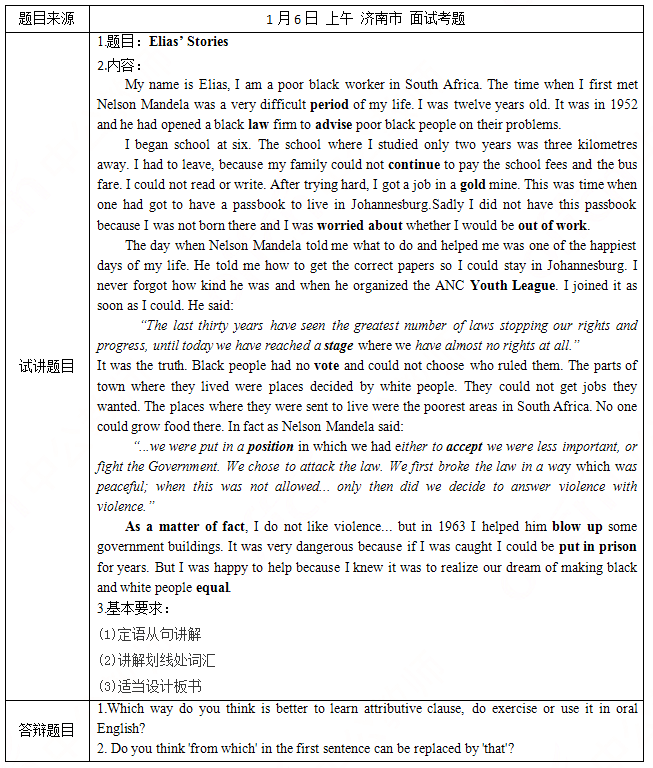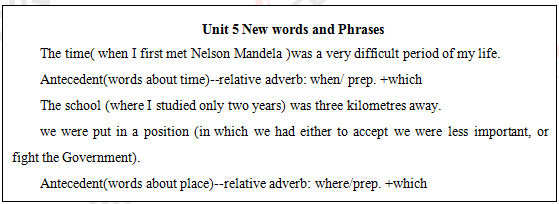Grammar is a description of the()of a language and the way in which linguistic units such as words and phrases are combined to produce sentences in the language.
题目
相似考题
更多“Grammar is a description of the()of a language and the way in which linguistic units such as words and phrases are combined to produce sentences in the language.”相关问题
-
第1题:
( ) studies the ways words are combined to form. sentences in a language ./font
A、Phonetics
B、Phonology
C、Morphology
D、Syntax
参考答案:D
-
第2题:
Extra-linguistic context refers to factors beyond language.( )此题为判断题(对,错)。
正确答案:正确
-
第3题:
Grammar studies how words and phrases are grammatically organized and formed.()
参考答案:正确
-
第4题:
according to wang qiang, the way a language teacher learned a language will influence the way he ___ to some extent.A、learns his mother tongue
B、learns a language
C、obtains linguistic knowledge
D、teaches a language
参考答案:D
-
第5题:
In PPP method classes or sequences, the teacher presents the context and situation for the language, and both explains and demonstrates the meaning and form of the new language. The students then practice making sentences before going on to another stage in which they talk or write more freely. PPP stands for except__________.A.Presentation
B.Procedures
C.Production
D.Practice答案:B解析:考查3P教学法。题目问的是:PPP教学模式是教师先通过语境呈现并讲解语言点,后让学生经过反复、大量的操练后再达到自由运用表达的程度。PPP教学模式是什么 PPP教学模式是“讲解(presentation)、操练(practice)、运用(production)”这一沿用已久的传统教学模式。在这种“标准”下,中国英语语法教学大体表现为以教师为中心、采取灌输教学法、运用题海战术。我们可以排除B选项。 -
第6题:
高中英语?语法
一、考题回顾

二、考题解析
【教案】
Teaching aims:
Knowledge aims:
(1)Students are able to master the meaning of bold words and phrases: period, law, advise, gold, worried about, out of work, Youth League, stage, stage, position, as a matter of fact, blow up, put in prison, equal
(2)Students can master the usage of adverb in attributive clause.
(3)After this lesson, students can know the difference of usage of adverb in attributive clause and the usage of pronoun in attributive clause.
Ability aim:
After this lesson, students can use grammar of attributive clause in reading and writing.
Emotional aim:
Students are able to love learning English after this lesson.
Key and difficult point:
Key Point: master the meaning of words and phrases :period, law, advise,gold,worried about etc.
Difficult Point: use grammar of attributive clause in reading and writing
Teaching procedures:
Step 1: Warming-up
1. Greetings.
2. Ask students to make several sentences using the grammar of usage of pronoun in attributive clause. Then write a sentence needing to use adverb in attributive clause. And then lead in the new grammar, adverb in attributive clause.
Step 2: Presentation
1.Ask students to open the book and read the passage to guess the meaning the bold words and then paraphrase the bold words with the help of PPT.
2. Then Ask students to find out more complex sentences that the clause is after a noun or pronoun and the words that are used to introduce the sentences: where, when, why or preposition plus which.
The time( when I first met Nelson Mandela )was a very difficult period of my life.
The school (where I studied only two years) was three kilometres away.
This was time (when one had got to have a passbook )to live in Johannesburg.
we were put in a position (in which we had either to accept we were less important, or fight the Government). ...
Then ask students to find the similarity of these sentences and invite several students to share their ideas. Then lead the students to conclude the rules of relative adverb in attributive clause and preposition plus which in attributive clause. (They all function as adverbials)
Step 3: Practice
1.Make sentences: Ask students to use the grammar that has just learnt to describe the pictures which are presented on the PPT.
2.Combine the sentences: Ask students to combine the sentences according to the grammar in attributive clause.
(1)This is a book. Its cover is blue. (whose)
(2)He is the teacher. He helped me. (who/that)
(3)Beijing is the place. I was born in this place. (where/ in which)
(4)This is the hotel. You will stay at the hotel. (where/at which)
Step4: Production
1.Make stories: Ask students to use the grammar that has just learnt to describe the video.
2.Discussion: Ask students to tell their daily life to use the grammar that has just learnt. And after 5minutes to invite several students to share their daily life.
Step5: Summary and Homework
Summary: ask a student to conclude the content of the lesson and summarize with the whole class.
Homework: write a short passage about his daily life using the grammar that has just learnt.
Blackboard design:

1.Which way do you think is better to learn attributive clause, do exercise or use it in oral English?
2. Do you think 'from which' in the first sentence can be replaced by 'that'?答案:解析:1.
(1)I think, first, the best way to learn attributive clause is tell the definition of this grammar in
sentence. For example, this is a beautiful teacher (who wears the red dress )is our teacher. Then ask students to pay attention to the clause to find the features of this sentence and conclude the attributive clause: noun/pronoun plus a whole sentence. Next tell the usage of pronoun in attributive clause. Last, teach the usage of adverb in attributive clause.
(2) Exercise and oral English should use togerther in practice attributive clasue. Doing exercise can make students master the structure of this grammar easily. And oral English can make students know the real situation of attributive clause in our daily life.
2.
No, I don’t think. From which is an relative adverb from the point of grammar. And that belongs to the pronoun. So it only can be used as the subject, object and so on but can not be used as the adverb or as as phrase. And this sentence doesn’t have the adverb, so we must use from which. -
第7题:
()deals with the way in which a language varies through geographical space.
- A、Linguistic geography
- B、Lexicology
- C、Lexicography
- D、Sociolinguistics
正确答案:A -
第8题:
Morphology studies how words can be formed to produce meaningful sentences.
正确答案:错误 -
第9题:
填空题Language is p()in that it makes possible the construction and interpretation of new signals by its users. In other words, they can produce and understand an infinitely large number of sentences which they have never heard before.正确答案: productive解析: 暂无解析 -
第10题:
单选题When teaching ____, teachers should not only focus on words or grammar, but also foster the ability to understand the relationship between sound, grammar and lexis, as well as a capacity to infer and determine relationships between sentences.Alistening
Bspeaking
Creading
Dwriting
正确答案: A解析: -
第11题:
单选题Which of the following cannot be used as a way to show the stress pattern of words, phrases, and sentences?AFacial expressions.
BGestures.
CVoices.
DThe blackboard.
正确答案: B解析: -
第12题:
单选题The part of the grammar that represents a speaker’s knowledge of the structure of phrases and sentences is called _____.Alexicon
Bmorphology
Csyntax
Dsemantics
正确答案: B解析:
代表说话者对短语和句子结构的认识的语法部分被称为句法。syntax句法。lexicon词汇。morphology形态学。semantics语义学。 -
第13题:
_____is an approach to grammar teaching in which students are taught rules first and then students try to apply the rules to practice and actual use of the language.A.Deductive learning
B.Inductive learning
C.Conductive learning
D.Instructive learning
正确答案:A
-
第14题:
Linguistic context refers to the words, clauses, sentences, paragraphs andeven cultural background.( )此题为判断题(对,错)。
正确答案:错误
-
第15题:
there are many situations in which we use more than one language skill, so it is valuable to integrate the four skills to _________.A、enhance the students' communicative competence
B、combine pronunciation, vocabulary and grammar
C、Combine words,phrases and sentences
D、use body language and pictures
参考答案:A
-
第16题:
Which of the following grammar activities is most communicative?A.Asking the students to read and correct the mistakes in the sentences.
B.Asking the students to tell the differences between two pictures in groups.
C.Asking the students to make sentences with the given words.
D.Asking the students to complete the translation exercises.答案:B解析:考查语法教学活动。
题干意思为:下列哪项语法教学活动最具有交际性纵观选项
B项需要学生将所学知识进行实践化的训练和运用,通过小组活动的形式描述两张图片差异的同时,充分体现了交际性的原则。故此题的正确选项为B。
A、C、D都属于机械式的练习活动,不合题意,故排除。
故此题的正确选项为B。 -
第17题:
Which of the following is a typical feature of formal writing
A.Archaic words are usually preferred.
B.The precision of language is a priority.
C.Short and incomplete sentences are preferred.
D.An intimate relationship with the audience is established.答案:B解析:考查写作教学。句意为“下面哪项是正式文体写作的典型特征”A项“偏好使用古体词”,B项“首先要保证语言的准确性”,C项“偏好使用简短、不完整的句子”,D项“跟读者建立亲密的关系”。正式文体的要求首先是用词准确无歧义,如法律文书。故选B。 -
第18题:
According to Krashen, there is only one way for human to acquire language. What is it?
By understanding meaningful messages or comprehensible input; the formula is i + 1.
略 -
第19题:
Language is p()in that it makes possible the construction and interpretation of new signals by its users. In other words, they can produce and understand an infinitely large number of sentences which they have never heard before.
正确答案:productive -
第20题:
填空题Grammar is a description of the()of a language and the way in which linguistic units such as words and phrases are combined to produce sentences in the language.正确答案: structure解析: 暂无解析 -
第21题:
问答题Directions: In this part of the test, you will write ONE sentence that is based on a picture. With each picture, you will be given TWO words or phrases that you must use in your sentence. You can change the forms of the words and you can use the words in any order. Your sentences will be scored on:•the appropriate use of grammar and•the relevance of the sentence to the pictureYou will have 8 minutes to complete this part of the test.Practice 1Directions: Write ONE sentence based on the picture, using the TWO words or phrases beneath it. You may change the forms of the words and you may use them, in any order.正确答案: (1) In the picture, two airplanes are by the field.
(2) The airplane is by another plane.
(3) I see a field by the airplane.
(4) Many trees are by the airplanes and the buildings.
(5) There are two airplanes parked by the field解析: 暂无解析 -
第22题:
单选题Which of the following grammar activities is most communicative?AAsking the students to read and correct the mistakes in the sentences.
BAsking the students to tell the differences between two pictures in groups.
CAsking the students to make sentences with the given words.
DAsking the students to complete the translation exercises.
正确答案: A解析: -
第23题:
单选题Which of the following is a typical feature of formal writing?AArchaic words are usually preferred.
BThe precision of language is a priority.
CShort and incomplete sentences are preferred.
DAn intimate relationship with the audience is established.
正确答案: D解析:
